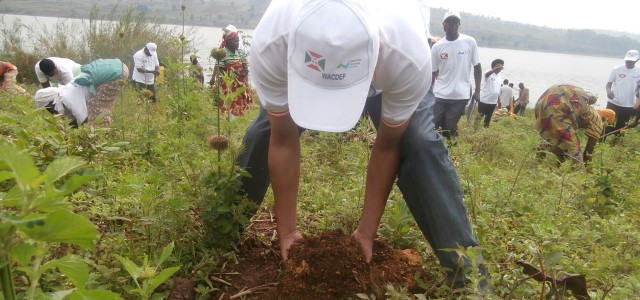Summary
In an ambitious effort to improve climate resilience at community level, GWP teamed up with a broad range of stakeholders to implement a pilot project in a transboundary catchment area. The project showcased the range of activities needed to bring about change: awareness-raising, stakeholder engagement, institutional capacity-building, and integration with government priorities. Among the many impacts, a key one has been an interest in rolling out the project into even more communities.
Background
In 2011, within the framework of the GWP-AMCOW Water, Climate and Development Programme (WACDEP), GWP Eastern Africa launched a pilot project aimed to enhance community resilience to climate change in the Lake Cyohoha catchment, located between Burundi and Rwanda.
Access to clean water, sanitation, energy, health services, and education are severely limited, with a disproportionate impact on women and children who are largely responsible for water and firewood collection. Food insecurity is a threat due to small plots, poor agricultural practices, land degradation, and population growth.
In addition, the legacy of civil wars and associated instability has led to large scale migration and unplanned settlement within the catchment. Consequently, the lake and its wetland systems, that provide local communities with socio-economic and environmental services, are threatened. Climate change poses a growing threat to the region and droughts and flood are more common.
GWP contribution
During the project design phase, the limited community capacities, including weak institutions, were identified as a major constraint to improved catchment management and greater resilience to the impacts of climate change.
Stakeholder ownership was largely achieved through a combination of close interaction with the local population at all stages of project implementation, with institutional buy-in from local authorities and national ministries. This set-up was made possible due to GWP’s neutral platform for engaging stakeholders.
GWP has been in constant engagement with many partners such as local government, private sector, youth and women groups. Burundi and Rwanda identified gaps on the existing mechanisms, and also identified additional tools for integrating issues of water security and climate resilience into sectoral planning processes. There has been huge political and institutional support in Rwanda from the ministries and NGOs.
Results
The project has improved living conditions and reduced vulnerability to climate change among the 30,000 catchment inhabitants.
Interventions considered to be no/low regret solutions such as biogas facilities, water supply infrastructure, and reforestation programs have directly benefited communities and demonstrated alternative, multi-beneficial solutions.
The large scale development of local institutional and community capacity on more sustainable catchment management practices and climate change adaptation, as well as the formal endorsement of the project itself, has succeeded in generating wider interest among communities and local government. This promotes the enforcement of regulations and encourages replication of demonstrated solutions.
The interventions in Rwanda are now considered as integral parts of the Bugesera District Development Plan, and in both countries the project has been implemented within existing national frameworks for climate change adaptation and water resources management.
The project is in line with the priorities identified within the National Adaptation Programmes of Actions (NAPAs) of Rwanda and Burundi, both of which prioritised Bugesera. This strengthens the sustainability of the project results and institutional structures on which they depend.
Throughout all activities, an emphasis on engaging through a broad stakeholder platform and encouraging community-owned interventions have been permanent features and provide the foundation for the overall project objective of strengthening the capacity and resilience of the local population to independently manage their resources more sustainably now and in the future.
Photo: Planting trees around Lake Cyohoha.

